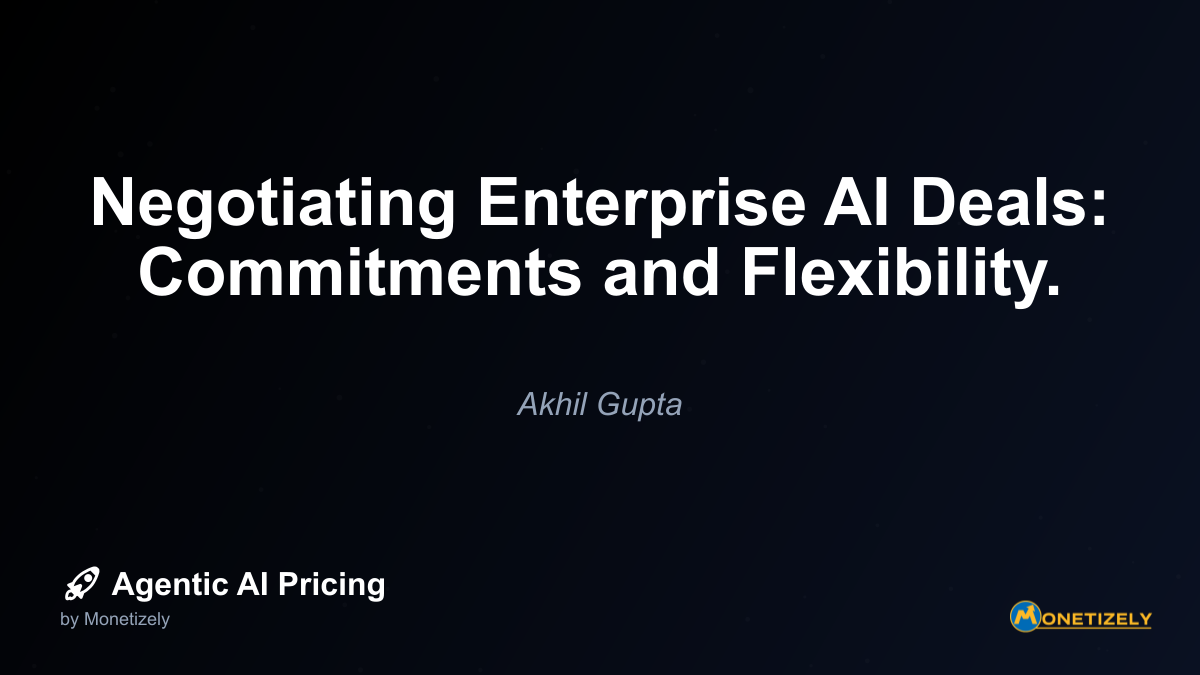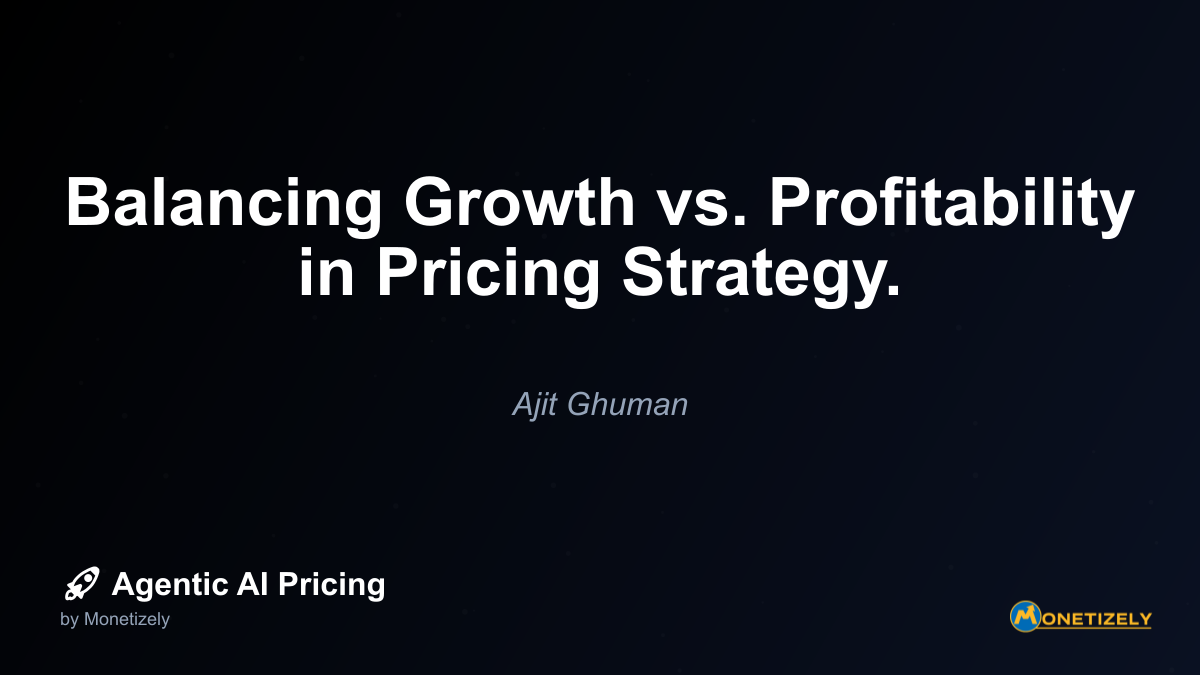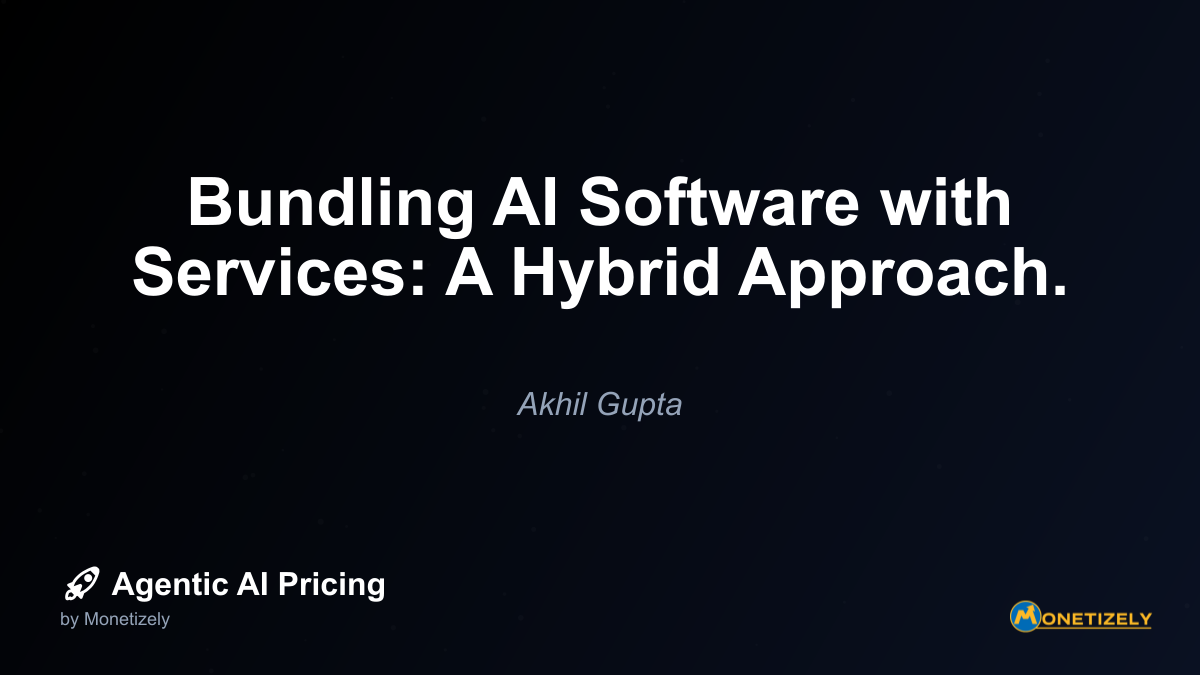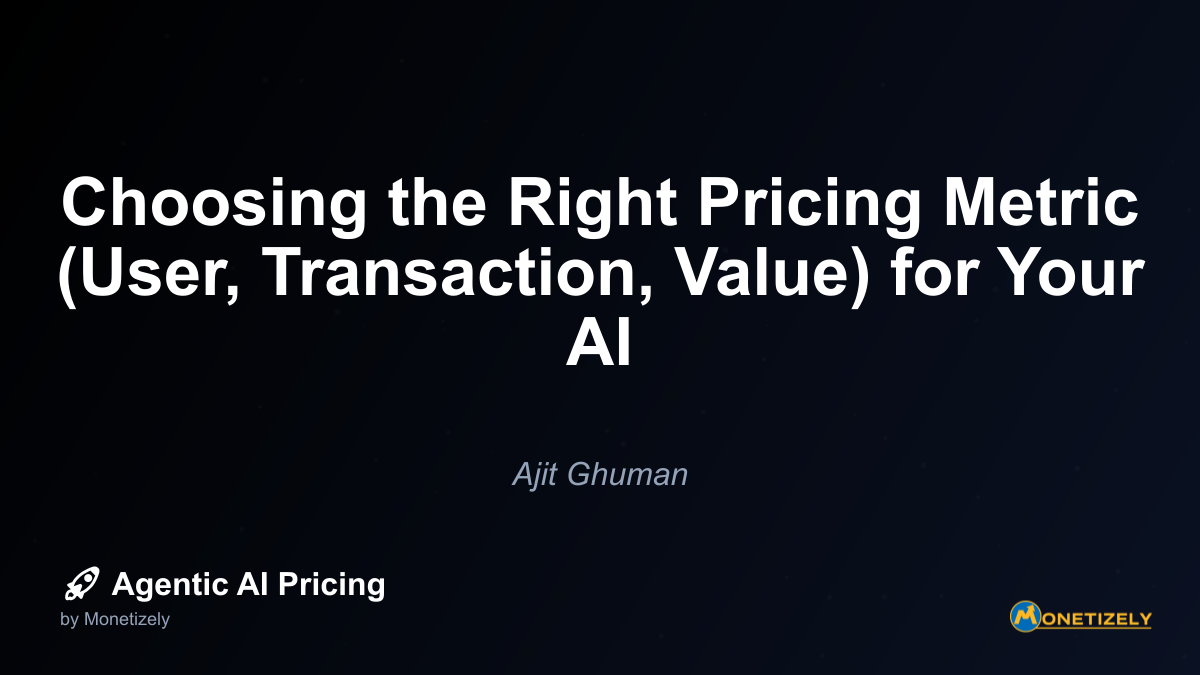· Akhil Gupta · Strategy & Planning · 6 min read
Negotiating Enterprise AI Deals: Commitments and Flexibility.
AI and SaaS Pricing Masterclass
Learn the art of strategic pricing directly from industry experts. Our comprehensive course provides frameworks and methodologies for optimizing your pricing strategy in the evolving AI landscape. Earn a professional certification that can be imported directly to your LinkedIn profile.

For AI vendors, a framework for accountability in performance guarantees helps ensure that exit clauses are tied to objectively measurable outcomes rather than subjective assessments. This creates a fair balance between client protection and vendor security.
Phased Commitments with Proof Points
Rather than requiring full commitment upfront, many successful enterprise AI deals incorporate phased approaches:
- Pilot phase: Limited scope, minimal commitment, focused on proving technical feasibility
- Initial deployment: Moderate commitment following successful pilot, targeting specific use cases
- Full implementation: Larger commitment based on demonstrated success in initial deployment
- Expansion phase: Additional commitments for new use cases or business units
This approach reduces client risk while establishing clear success criteria for advancing to higher commitment levels. For vendors, it creates natural expansion opportunities while demonstrating confidence in solution value.
Remediation Periods
Well-structured contracts include remediation periods before exit clauses can be triggered. These typically range from 30-90 days, providing vendors reasonable time to address issues while ensuring clients aren’t indefinitely locked into underperforming solutions.
The remediation process should include:
- Clear notification requirements
- Specific issue documentation
- Collaborative problem-solving procedures
- Defined success criteria for remediation
- Escalation paths if initial efforts fail
This approach acknowledges that complex AI implementations may encounter challenges while providing frameworks to address them constructively.
Handling Custom Terms for Enterprise Clients
Enterprise clients often request custom terms that diverge from standard agreements. Navigating these requests requires balancing customer accommodation with operational sustainability.
Common Enterprise Custom Terms
Several customization requests appear frequently in enterprise AI negotiations:
1. Custom SLAs and Support Tiers
Enterprises frequently request enhanced service level agreements (SLAs) and support beyond standard offerings. Rather than creating completely bespoke arrangements, successful vendors develop enterprise-specific tiers that:
- Offer improved response times (e.g., 1-hour vs. 4-hour for critical issues)
- Provide dedicated technical account managers
- Include regular business reviews and optimization sessions
- Guarantee minimum uptime percentages with financial remedies
- Offer priority access to product teams for feedback
These enhanced services justify premium pricing while maintaining operational scalability.
2. Data Residency and Security Requirements
With increasing regulatory complexity, data handling requirements often drive custom terms. Common requests include:
- Geographic restrictions on data processing
- Enhanced encryption requirements
- Specific audit rights and compliance certifications
- Custom penetration testing allowances
- Specialized breach notification procedures
Vendors must evaluate these requests against their technical architecture and compliance capabilities, potentially offering tiered security options rather than unlimited customization.
3. Custom Integration and API Usage
Enterprise environments typically involve complex integration requirements. Successful negotiations address:
- API rate limits and throughput guarantees
- Custom integration development and maintenance
- Data transformation and normalization services
- Legacy system compatibility requirements
- Development environment access and testing procedures
Vendors should distinguish between reasonable integration requirements and requests that would require fundamental platform changes, pricing the former appropriately while declining the latter.
Pricing Strategies for Custom Enterprise Terms
Custom terms create value for clients but impose costs on vendors. Effective pricing approaches include:
1. Tiered Enterprise Packages
Rather than negotiating each custom term individually, many vendors develop enterprise tiers that bundle common requests:
| Tier | Commitment Level | Custom Terms Included |
|---|---|---|
| Standard | $X | Basic SLA, standard support, standard security |
| Enterprise | 2X | Enhanced SLA, dedicated support, advanced security, limited customization |
| Enterprise+ | 3X+ | Premium SLA, TAM, highest security, extensive customization |
This approach simplifies negotiations while ensuring custom terms are appropriately valued.
2. Professional Services Attachment
Some customizations are best handled through professional services rather than product modifications. Creating clear boundaries between:
- Core product functionality (included in subscription)
- Configuration options (included or tiered)
- Custom development (separately priced professional services)
- Managed services (ongoing operational support)
This approach maintains product scalability while accommodating customer needs through appropriate service channels.
3. Value-Based Pricing for Strategic Customizations
For truly unique requirements that deliver significant client value, value-based pricing approaches may be appropriate. These might include:
- Success-based fees tied to specific outcomes
- Shared risk/reward models for innovative implementations
- Co-development arrangements with IP sharing components
- Joint go-to-market opportunities for industry-specific solutions
These approaches recognize that some customizations create mutual strategic value beyond the immediate transaction.
Negotiation Tactics and Best Practices
Successful enterprise AI deal negotiations require both strategy and tactical execution.
Preparation Phase
Before formal negotiations begin:
- Understand the client’s full ecosystem - technical environment, business processes, stakeholder dynamics, and success criteria
- Identify decision-makers vs. influencers - distinguish between technical evaluators, business sponsors, procurement specialists, and ultimate decision authorities
- Map competitive alternatives - understand what other solutions they’re considering and your relative strengths/weaknesses
- Establish value metrics - determine how the client will measure success and quantify potential value
- Define your walkaway position - know in advance what terms would make the deal unsustainable
During Negotiation
Effective tactics during active negotiation include:
- Separate value discussion from pricing discussion - establish solution value before addressing specific terms
- Use anchoring effectively - start with your optimal position while maintaining credibility
- Bundle concessions rather than making them individually - create packages that address multiple concerns simultaneously
- Maintain multiple negotiation paths - explore different combinations of terms rather than linear bargaining
- Focus on total relationship value - emphasize lifetime partnership over initial contract terms
Post-Agreement Success Factors
The negotiation doesn’t end with signing. Critical post-agreement elements include:
- Clear implementation milestones with assigned responsibilities
- Regular business reviews tied to success metrics
- Proactive expansion planning for additional use cases
- Executive sponsorship maintenance to ensure ongoing alignment
- Value documentation to support renewal negotiations
Case Study: Balancing Flexibility and Commitment
A leading enterprise AI solution provider successfully transformed their enterprise deal structure by implementing a “commitment corridor” approach that balanced predictability with flexibility:
- Base commitment tier: Minimum usage level with maximum discount (40%)
- Expected usage tier: Projected normal usage with standard enterprise discount (25%)
- Burst capacity: On-demand usage above expected tier at moderate discount (15%)
- Quarterly true-ups: Adjustments if usage consistently exceeded expected tier
- Annual reset option: Ability to reset commitment levels based on actual usage patterns
- Performance-based exit: Clearly defined performance metrics with 60-day remediation period
This structure provided the client budget predictability while accommodating growth uncertainty, and gave the vendor committed revenue with expansion opportunity. The deal resulted in a 3-year agreement with 40% higher initial commitment than previously proposed and ultimately 85% higher actual usage than the base commitment level.
Conclusion: Creating Sustainable Win-Win Agreements
The most successful enterprise AI deals create genuine mutual value rather than zero-sum negotiations. This requires vendors to understand client business objectives beyond technical requirements, and clients to appreciate the economics of sustainable AI solution development.
Key principles for creating these win-win agreements include:
- Transparency in value exchange - clearly articulate what each party gives and receives
- Appropriate risk allocation - assign risks to the party best positioned to manage them
- Growth alignment - create structures where vendor success depends on client success
- Operational feasibility - ensure agreements can be executed without extraordinary effort
- Relationship foundation - build terms that encourage partnership rather than adversarial monitoring
As enterprise AI adoption accelerates, the organizations that master these negotiation principles will create more valuable, sustainable relationships that drive innovation and competitive advantage. The most successful vendors recognize that flexibility and commitment aren’t opposing forces but complementary elements of deals that truly serve both parties’ long-term interests.
By approaching enterprise AI negotiations with these principles, both vendors and clients can move beyond transactional bargaining to create strategic partnerships that deliver lasting value in an increasingly AI-driven business landscape.
Co-Founder & COO
Akhil is an Engineering leader with over 16+ years of experience in building, managing and scaling web-scale, high throughput enterprise applications and teams. He has worked with and led technology teams at FabAlley, BuildSupply and Healthians. He is a graduate from Delhi College of Engineering and UC Berkeley certified CTO.
Pricing Strategy Audit
Let our experts analyze your current pricing strategy and identify opportunities for improvement. Our data-driven assessment will help you unlock untapped revenue potential and optimize your AI pricing approach.




